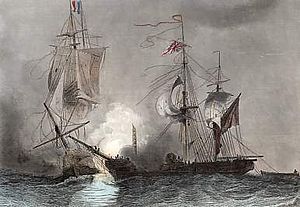French frigate Alcmène (1811)
 HMS Venerable fighting the French frigate Alcmène on 16 January 1814
| |
| History | |
|---|---|
| Name | Alcmène |
| Laid down | July 1810 |
| Launched | 3 October 1811 |
| Captured | 16 January 1814 |
| Name | Dunira |
| Acquired | 16 January 1814 (by capture) |
| Renamed | HMS Immortalite |
| Fate | Sold 1837 |
| General characteristics | |
| Class and type | Armide-class |
| Type | frigate |
| Length |
|
| Beam | 39 ft 10 in (12.14 m) |
| Depth of hold | 12 ft 7+1⁄2 in (3.848 m) |
| Propulsion | Sails |
| Complement |
|
| Armament |
|
The French frigate Alcmène was an Armide-class frigate of a nominal 44 guns, launched in 1811. The British captured her on 1814. The Royal Navy named her HMS Dunira, and then renamed her HMS Immortalite but never commissioned her nor fitted her for sea. In March 1822 she became a receiving ship at Portsmouth. She was sold in January 1837.
In 1813, along with Iphigénie, she served at Cherbourg, in the squadron of contre-amiral Amable Troude, to protect the harbour.
Capture[]

On 16 January 1814, the 74-gun third-rate ship of the line Venerable, her prize, the ex-French letter of marque brig Jason, and Cyane were in company when they spotted two 44-gun French frigates, Alcmène and Iphigénie. Venerable joined her and after a chase that left Cyane far behind, captured Alcmène, though not without a fight. Venerable lost two men dead and four wounded, while the French lost 32 dead and 50 wounded. Alcmène had a complement of 319 men under the command of Commander Ducrest de Villeneuve, who was wounded when he brought her alongside Venerable and attempted a boarding.[1]
Jason and Cyane tracked Iphigénie and initially fired on her but broke off the engagement because they were outgunned. Cyane continued the chase for over three days until Venerable was able to rejoin the fight after having sailed 153 miles in the direction she believed that Iphigénie had taken. On 20 January 1814, Venerable captured Iphigénie', having again left Cyane behind. Iphigénie apparently did not resist after Venerable came up.[a] Before meeting up with the British ships, the two French vessels had taken some eight prizes.[3] The action resulted in the award in 1847, to any surviving claimants, of the Naval General Service Medal with clasps "Venerable 16 Jany 1814" and "Cyane 16 Jany. 1814".[4]
Venerable was able to locate Iphigénie because Commander Ducrest de Villeneuve of Alcmène was so angry at Captain Émeric, who was the senior French commander, for not having come alongside Venerable on the other side also to board, that he essentially revealed the rendezvous instructions to Admiral Durham. (Venerable was Durham's flagship). When some prisoners from Iphigénie's crew were brought on Venerable, crew from Alcmène too were enraged. Durham had to station Royal Marines between them, with fixed bayonets, to prevent fighting from breaking out.[5]
Fate[]
The Royal Navy never commissioned Alcmène. The Admiralty initially named her Dunira.[6] On 8 July, Lieutenant Edward Boys, formerly of Venerable, was confirmed in command of Dunira, but was put on half-pay in September.[7] Then on 8 November the Admiralty renamed her Immortalite.[8]
Immortalite became a receiving ship at Portsmouth in March 1822. She may have served for a while in the Quarantine Service at Standgate Creek.[9] She was sold in January 1837 to a Mr. W. Goldsworthy for £1,610.[8]
Notes. citations, references[]
Notes
Citations
- ^ ’’Naval Chronicle’’, Vol. 31, pp.244-5.
- ^ "No. 17048". The London Gazette. 5 August 1815. p. 1599.
- ^ James & Chamier (1837), Vol. 6, pp.259-61.
- ^ "No. 20939". The London Gazette. 26 January 1849. p. 244.
- ^ Long (1895), p. 199.
- ^ "NMM, vessel ID 365890" (PDF). Warship Histories, vol i. National Maritime Museum. Archived from the original (PDF) on 2 August 2011. Retrieved 30 July 2011.
- ^ O'Byrne (1849), pp. 112–3.
- ^ Jump up to: a b Winfield (2008), p. 178.
- ^ "NMM, vessel ID 368870" (PDF). Warship Histories, vol i. National Maritime Museum. Archived from the original (PDF) on 2 August 2011. Retrieved 30 July 2011.
References
- James, William & Frederick Chamier (1837) The naval history of Great Britain : from the declaration of war by France in 1793 to the accession of George IV. (London: R. Bentley).
- Long, W.H. (1895). Medals of the British Navy and how They Were Won: With a List of Those Officers, who for Their Gallant Conduct Were Granted Honorary Swords and Plate by the Committee of the Patriotic Fund. Norie & Wilson.
- O'Byrne, William Richard (1849), Naval Biographical Dictionary
- O'Byrne, W.R. (1849). A Naval Biographical Dictionary: Comprising the Life and Services of Every Living Officer in Her Majesty's Navy, from the Rank of Admiral of the Fleet to that of Lieutenant, Inclusive. A Naval Biographical Dictionary: Comprising the Life and Services of Every Living Officer in Her Majesty's Navy, from the Rank of Admiral of the Fleet to that of Lieutenant, Inclusive. 1. J. Murray.
- Winfield, Rif (2008). British Warships in the Age of Sail 1793–1817: Design, Construction, Careers and Fates. Seaforth. ISBN 1-86176-246-1.
This article includes data released under a Creative Commons Attribution-ShareAlike 3.0 Unported UK: England & Wales Licence, by the National Maritime Museum, as part of the Warship Histories project.
- Frigates of the Royal Navy
- 1811 ships
- Ships built in France
- Captured ships